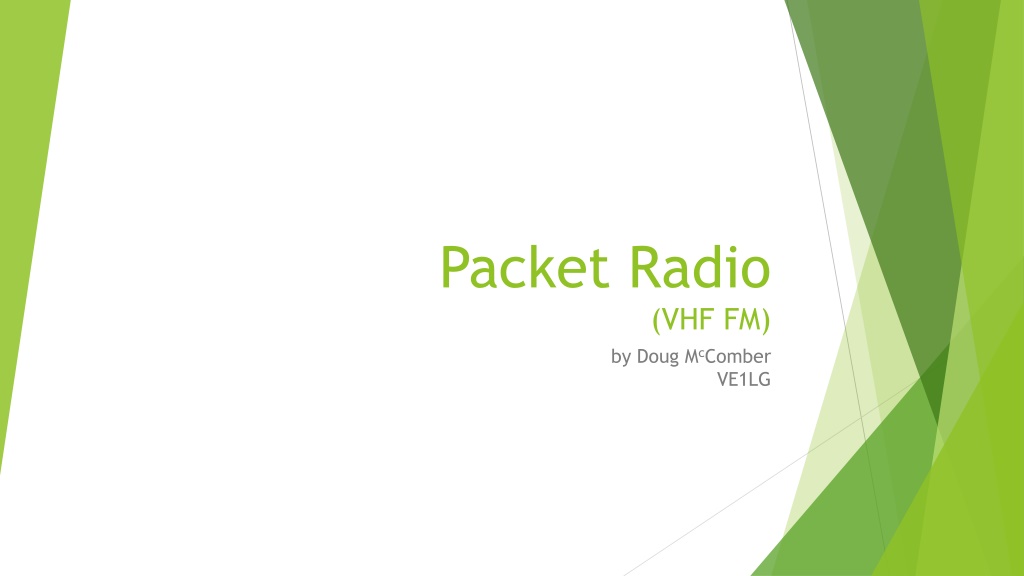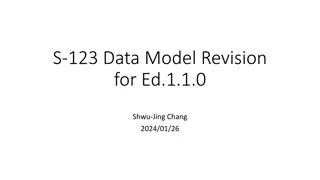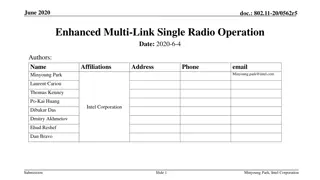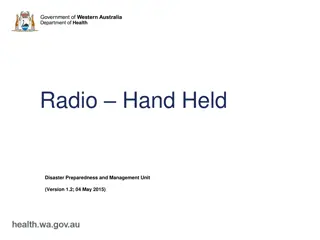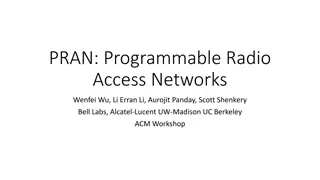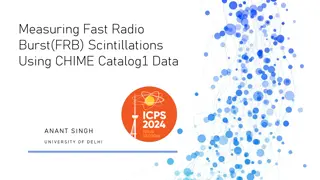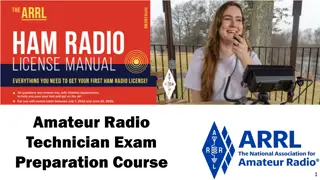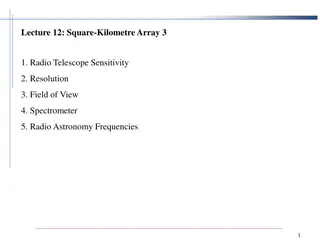Understanding Packet Radio: A Comprehensive Guide
Packet radio, utilizing VHF FM technology, is a digital mode allowing keyboard-to-keyboard communication, messaging, mailboxes, bulletins, and more. It uses the AX.25 protocol and operates at varying data rates on VHF and HF bands. The system comprises basic stations and automated nodes, each requiring a radio, TNC, and often a computer. Various hardware TNC options are available for packet radio enthusiasts, aiding in establishing connections and providing services. Despite advancements, adoption of modernized speeds remains modest.
Download Presentation

Please find below an Image/Link to download the presentation.
The content on the website is provided AS IS for your information and personal use only. It may not be sold, licensed, or shared on other websites without obtaining consent from the author. Download presentation by click this link. If you encounter any issues during the download, it is possible that the publisher has removed the file from their server.
E N D
Presentation Transcript
Packet Radio (VHF FM) by Doug McComber VE1LG
What is Packet Radio? Digital mode Keyboard to keyboard (predominantly on HF) Messaging Mailboxes Bulletins Interactive text-based services Games DX clusters Information services APRS (Automatic Packet Reporting System) In some circles APRS is synonymous with Packet Radio, but in reality APRS just uses Packet Radio technology while adhering to an agreed upon set of standards for positional data exchange.
What is Packet Radio Uses the AX.25 protocol for the data link layer. Other data link layers you may have heard of are Ethernet and 802.11 (WiFi). FM on VHF, or SSB on HF Data rate is commonly 1200 baud on VHF, which is about 1440 words per minute, but still quite slow by today s standards. This is 48 times slower than the best dial-up Internet (56k) we had back in the day . 9600 baud is possible but uncommon. On HF data rate is 300 baud or about 360 words per minute. There are some interesting advances in modernizing Packet Radio speeds with new hardware/software and protocols, but adoption remains low and stagant.
Packet Radio Station Types There are two basic types of Packet Radio stations A basic station Operator uses station for keyboard to keyboard or connecting to a node. May have simple mailbox for other stations to leave messages. A Packet Radio Node Nodes are automated and provide services to Packet Radio stations. Services can include but are not limited to: Information services Games (not common) Connection to other nodes Connection to a DX cluster Connection to a Bulletin Board System (BBS)
Station Components All Packet Radio stations require a radio and a terminal node controller (TNC). Most also require a computer of some type. The TNC receives Packet Radio audio from the radio and de-modulates it. It speaks AX.25 so the computer is only really used as a display. The TNC also receives text from the computer, translates it into AX.25 and modulates it out to the radio from transmission. TNC s can be hardware or software. Hardware TNC s are reliable and suitable for long term unattended operation but can be hard to obtain and are somewhat expensive. Software TNC s can be more challenging to set up but are generally free. It is common today for nodes to be hardware-based and regular stations to be software-based. Some radios also have TNC s built-in.
Hardware TNCs Kantronics Still in business Excellent products Expensive (cheapest TNC is $250USD) Mobilinkd Modern Bluetooth A bit more affordable ($150USD) Focused on APRS but can work are a regular Packet Radio TNC Used Market eBay tends to be expensive for the better models ($175CDN) Flea markets often have them for around $50.
Software TNCs UZ7HO s Sound Modem (Windows) Free and kept up to date. A bit complicated to set up but once you get it dialed in it works very well. Compatible with KISS (a standard TNC language ) and AGWPE (another sound modem). AGWPE (Windows) Free and old (last updated in 2013). More complicated than UZ7HO s Sound Modem but also works very well. Dire Wolf (Windows, Linux, macOS) Free/open source, and kept up to date. More complicated to set up but there is lots of information and support available. Lot s of features and capability the other two don t have.
Radios Radios with a built-in TNC: Out of production: Kenwood TM-D710 and 700 mobiles Kenwood TH-D72, D7 and D74 HT s Yaesu FT-8800 and 8900 mobiles Current production: Kenwood TH-D75 Radios without a built-in TNC: Any will do so long as it has a mic port and can be put in TX via the same port (VOX will not work).
Software Hardware TNC s are designed such that you do not need special software to use them. They do all the work so they really just need a display. That display is known as a terminal. This means you could connect anything from a Commodore 64 to the latest MacBook Pro to a TNC and operate Packet Radio. Some examples of terminal software include: Windows Putty Linux screen Agetty macOS screen
Software Most hardware TNC s can be put in a proprietary command mode or the standards-based KISS mode to be used with special Packet Radio software rather than using a terminal. Unfortunately software that takes advantage of these TNC modes are old and require either MS-DOS or a version of Windows that can execute 16-bit programs (sometimes 32-bit XP but often Win98 or earlier). These programs are full featured and make things like messaging and bulletins a breeze. There are a couple of modern programs, one is good but missing some features, the other has all the features but is overly complex. More work is needed in this area for Packet Radio in the 21stcentury.
Connecting to Another Packet Station Packet radio stations connect to one another with a handshake process before further station to station communication can take place. Typically an operator issues a connect command (often abbreviate to just c ) from their TNC or software. C VE1LG-7 If you cannot reach the other station directly, you may be able to use an intermediary station. This is called digipeating. You connect to a station via another (or multiple). C VE1LG-7 V VE1XYZ What happens once you are connected depends on what type of station you ve connected to. It may be another operator and you can commence a keyboard to keyboard QSO. Or it may be a node with services of some type and you are prompted to enter certain commands. To end the QSO or leave the node you either enter a TNC-specific command to disconnect or more commonly you simply type bye .
MARCAN Packet Network There is an extensive network of packet radio nodes in the Maritimes, similar to the MAVCOM system. These nodes run hardware TNC s with a third-party ROM (the node s software) called The Net. There are no services on the nodes but they allow you to connect to other nodes. This is similar to digipeating but is NOT to be confused with digipeating. You cannot use a MARCAN node to connect to another station using the via command. You can use scripts, however, to accomplish the same thing in many cases. While you can hop all around the Maritimes (and even beyond) using the MARCAN network, it will get very slow and even unreliable the more hops you make. One hop works well. Two is do-able . Beyond that isn t practical. KCARC operates the MARCAN node VE1AEH at 145.090 VE1LG is on the same frequency so VE1AEH can be used to reach it.
VE1LG Node Station Yaesu FT-2500M Mac Mini running Linux LinBPQ packet node/bbs software Various custom scripts for services Services VE1LG-7 Node Latest close-by APRS stations Weather Space Weather Zork, Infocom s 80 s text adventure News headlines Wordle, popular word game networked with other packet stations world-wide Connect to other packet stations via RF or AXIP (AX.25 over Internet) All other SSID services on the following slide can be accessed from VE1LG-7 or direct
VE1LG Node Services VE1LG-1 BBS Bulletins, regional and world-wide Personal messaging Files VE1LG-2 DX Cluster Full implementation of a DX Spider-based cluster VE1LG-4 Chat Chat with other packet stations on other BPQ/LinBPQ nodes VE1LG-10 RMS Winlink Keyboard direct interface or; Winlink Express
Links Sound Modems that work as KISS TNC s UZ7HO Soundmodem and Easyterm http://uz7.ho.ua/packetradio.htm Direwolf https://github.com/wb2osz/direwolf AGWPE https://www.sv2agw.com/downloads Hardware TNC s Kantroncis KPC-3 https://kantronics.com/kpc-3/ Mobilinkd http://www.mobilinkd.com/ Digirig https://digirig.net/ Software Outpost Packet Message Manager https://outpostpm.org/ Sally7 https://groups.io/g/Sally7 Winlink https://downloads.winlink.org/User%20Programs/
Links MARCAN maps and frequencies https://ve1cra.net/main/packet.html Network105 http://ww2bsa.org/ww2bsa-network105.htm Introduction to Packet Radio https://www.choisser.com/packet/ VE1LG Packet Radio Node Information: https://ve1lg.ca/packet.html
